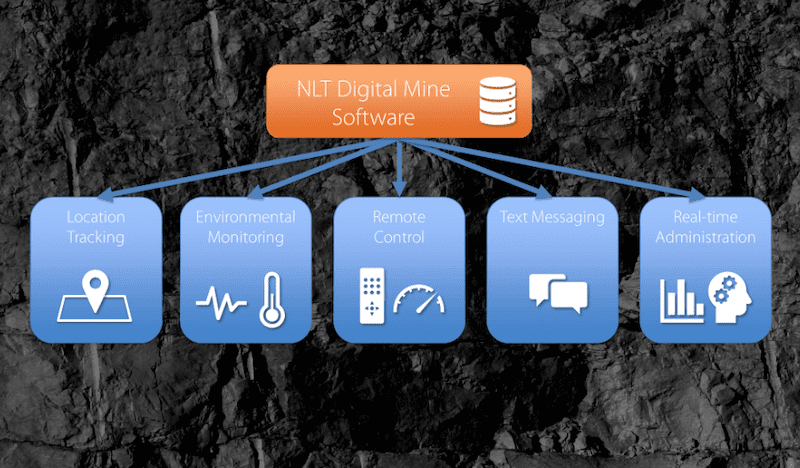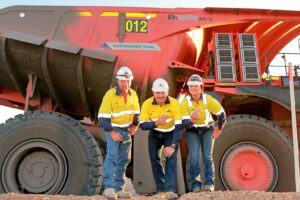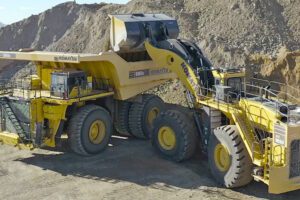There are some exciting new releases of safety technology coming to the market in 2019 that come with a promise to improve safety and productivity for the Australian mining industry. The new focus of suppliers on the Internet of Things (IoT) devices that interface with mine operating systems will no doubt be a game changer when it comes to advances in safety technology.
A Canadian based company with an office in Brisbane, Northern Light Technologies (NLT) is set to release a new line of IOT equipped headlamps to offer higher resolution personnel tracking and a number of other features in the second quarter of 2019.
READ RELATED CONTENT
- Kinetic wireless mesh enters agreement with Extronics
- Fortescue announce base for autonomous vehicle research and testing
- Smart mining helmet to revolutionise safety in mining
NLT Vigilance line will use Bluetooth low-energy tracking, which offers better location accuracy than RFID trackers and uses less battery power. According to NLT Managing Director Heidi Levitt, the product will come with an app-style interface and offer a cap-mounted camera.
“We’ve built in the camera, so a miner can take a picture of an incident or a piece of machinery that failed and can quickly send that up [to the surface] over the Wi-Fi network,” Levitt said.
She said the Vigilance lamps were designed not to be a special product, signed out for occasional use, but rather everyday lamps for all workers. One way to do this, she said, was by making the new lamps modular, so companies can customize what goes into the lamps they purchase.
It will also enable text messaging over a mine’s Wi-Fi network and can be powered by an IoT-capable processor, she said, which will give it wider functionality and expandability down the road.
Initially, NLT plan that the lamp will include sensors to measure speed and direction, with the company planning to add a suite of sensors to measure humidity and air pressure. Heidi stressed that “We can start to look at stress and fatigue due to the environment they’re working in.”
Northern Light Technologies (NLT) and Matrix Design Group, LLC (Matrix) announced late last year that the Matrix IntelliZone proximity detection system has received IECEx approval from the Department of Industry’s Mine Safety Technology Centre in Thornton, NSW, Australia.
Smart hard hats
Also in the new year, Jannatec Technologies will roll out a new generation of safety technology – smart hard hats. Depending on needs and budgets, the hat can be equipped with a video camera, Wi-Fi, LTE and Bluetooth capabilities as well as a collision avoidance option. The complete set up also includes a display and keypad that can be worn on the user’s wrist. Much of the technology is integrated into the brim of the hat, which can be snapped on and off and add other features as needed. This modular aspect was essential to the design, explained Mark Burnett, an account manager with Jannatec, as was the effort to make it work well with legacy systems. “We wanted to keep it as agnostic as possible. We don’t want the users to have to change their existing infrastructure.” The difference in weight compared to a standard hard hat he said, is negligible.
Protecting miners with their headgear is not the only area where technology is improving safety. Newtrax is developing a suite of products that will provide proximity detection not just between miners and equipment, but miners and their location in relation to a machine, according to product manager Patrice Corneau.
“In many cases, simply knowing the proximity of a worker may be inadequate. To provide the most effective protection, it would be advantageous to know the worker’s exact location relative to specific parts of the machine,” Corneau said. “To lay the foundation for measuring [this], Newtrax is developing a new generation of collision avoidance systems.”
The company already has a general proximity alert system available that gives an operator a notification if they are approaching a miner or another piece of equipment in their general vicinity. The collision avoidance system will take things to another level, giving more precise warnings to an operator. For example, instead of a just warning a driver there’s a miner nearby, it will be able to say there is a miner to the vehicle’s front-left. Those systems will use a combination of Chirp sensors and ultra-wideband (UWB) location tracking. The Chirp sensors are used to detect proximity at beyond 10 metres with an accuracy of about one metre, and the UWB is accurate to about 10 centimetres when objects are closer than 20 metres.
It is by combining these sensors in an array placed on the equipment that gives the system full sightline around the machine. This also gives them the ability to collect reams of data, which Newtrax hopes to use to perfect its algorithms to provide equipment operators with timely warnings, without drawing their attention away from actually running their machine. “The collected data allows us to track objects and develop an effective strategy to avoid or mitigate the impact of collisions through impaired visibility or loss of control,” he said.
“You would not want your operator to change focus to look at a screen in order to interpret the information and then take action,” Corneau said. “The ability to present simple notifications so that the operator remains focused and alert will certainly be the result of complex computations.”
There is a delicate balancing act, he said, in making sure the technology gives the operator enough notifications for them to respond before the system takes over entirely.
Remote operation will rise but proximity detection to advance
Dowling, Ontario-based Hard-Line offers a number of technologies meant for underground heavy equipment that allow remote operation in addition to proximity and collision detection. It has two systems for operators working underground within sight of their equipment. Brow Alert and Prox work in tandem to keep LHD operators protected.
Brow Alert, released in 2017, gives an operator a signal when they are approaching the edge of the safe zone, letting them exit the machine and switch over to radio-controlled operation. If the operator attempts to push past the “yellow zone” toward the brow, the system will shut down the scoop. The system relies on RFID tags mounted on the back of the drift that marks the yellow and red zones, which communicate with the tag reader mounted next to the scoop operator.
Prox comes into play when a miner disembarks from the machine and switches to radio-controlled operation. It sounds an alert if the operator gets too close to a remote-operated machine, and shuts it down completely if the miner comes inside a defined danger zone.
But, Hard-Line’s broader focus is on taking the operator out of the mine altogether.
“Teleremote operation is the ultimate solution for ensuring that operators remain out of harm’s way by removing the need for them to be underground at all. Our clients are using this technology to operate an array of equipment from hundreds of miles away from site,” Hard-Line vice-president of business development Felicia Brunelle said. “Safety risks associated with working underground and the downtime between shifts and blast cycles are reduced.”
The technology continues to gain traction, said Hard-Line’s senior vice-president of technology Ryan Siggelkow, as more mine operators begin to recognize the advantage of a remote workforce and the easy transition between shifts. “People are now accepting the technology as proven rather than a science project,” he said.
Trend tracking and safety technology integrate
With all of the items now connected and generating data, there is also the opportunity to improve practices while personnel continue to work underground. This is where SHYFT Inc’s LOCATE software comes in, said Trang Tran-Valade, the company’s president.
“It is engineered to be vendor-agnostic, allowing for seamless integration with most leading tagging solutions,” Tran-Valade said. “Location data transmitted by real-time location systems can be pulled into a single web-based, centralized interface where information is presented to mine personnel in an intuitive format.”
The system is accessible on a mobile device and uses a Microsoft platform to offer a way to analyze mine productivity and worker patterns, but it goes beyond into safety analysis. “For example, mine rescue teams can reduce evacuation time and focus efforts in key areas such as last known location of mine personnel,” she said.
“Data collected allows for better understanding of personnel movement history, vehicle patterns, historical emergency and evacuation patterns, such as average time to move to a safe zone, total evacuation time, and total number evacuated,” Tran-Valade said.
Read more Mining Safety News














Add Comment